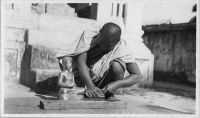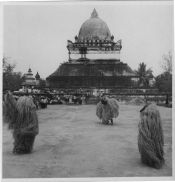Vers la photothèque de l'EFEO To the EFEO photo library Đến thư viện ảnh EFEO
-
Fonds patrimoniaux de l'EFEO
EFEO heritage collection
>> read morePhông ảnh di sản của EFEO>> đọc thêm
-
Fonds Sheppard Ferguson
Sheppard Ferguson's collection
>> read morePhông ảnh của Sheppard Ferguson>> đọc thêm
-
Chine - Tibet
China - Tibet
>> read moreTrung quốc - Tây Tạng>> đọc thêm
-
Thaïlande
Thailand
>> read moreThái Lan>> đọc thêm
-
Indonésie
Indonesia
>> read moreIndonesia>> đọc thêm
-
Vietnam
Vietnam
>> read moreViệt Nam>> đọc thêm
-
Cambodge
Cambodia
>> read moreCampuchia>> đọc thêm
-
Inde - Sri Lanka
India - Sri Lanka
>> read moreẤn Độ - Sri Lanka>> đọc thêm
-
Laos
Laos
>> read moreLào>> đọc thêm
Laos
Laos
Lào
Henri Parmentier est le premier à avoir constitué un fonds propre au Laos, à l’occasion des recherches qu’il a menées en 1911 et en 1927 sur les édifices religieux lao et phuan des bords du Mékong entre Khong et Luang Prabang, et sur le plateau de Xieng Khuang (clichés d’architecte préoccupé de relevés techniques et d’analyses formelles). Recruté à l’EFEO en 1919 comme inspecteur du service archéologique, Charles Batteur se voit notamment confier la restauration du Vat Sisaket, à Vientiane, en 1922-1923. Ses clichés nous livrent un témoignage unique sur la douceur et la simplicité de la vie à Luang Prabang au début du XXème siècle. Suivent les recherches de Charles Robequain, Suzanne Karpelès, Madeleine Colani et Paul Lévy, ou les restaurations de Louis Fombertaux. Les documentations photographiques conservées portent alors essentiellement sur du matériel préhistorique ou des détails techniques de bâti.
En 1950 la disparition prématurée, d’Henri Deydier, ne lui a pas permis de réaliser l’ambitieux programme de recherche qu’il s’était fixé. Du point de vue de l’iconographie, c’est sans doute Charles Archaimbault, qui laisse la documentation la plus importante illustrant très précisément les rituels du Sud du Laos.
Henri Parmentier was the first person to establish a collection specific to Laos, during the research he conducted in 1911 and 1927 on the Lao and Phuan religious buildings on the banks of the Mekong River between Khong and Luang Prabang, and on the Xieng Khuang plateau (architect's photographs concerned with technical surveys and formal analyses). Charles Batteur was recruited by the EFEO in 1919 as an inspector in the archaeological department and was entrusted with the restoration of Wat Sisaket in Vientiane in 1922-1923. His photographs provide us with a unique testimony to the gentleness and simplicity of life in Luang Prabang in the early 20th century. The research of Charles Robequain, Suzanne Karpelès, Madeleine Colani and Paul Lévy, or the restorations of Louis Fombertaux follow. The photographic documentation preserved at that time was essentially about prehistoric material or technical building details.
In 1950 the premature death of Henri Deydier did not allow him to carry out the ambitious research program he had set for himself. From the point of view of iconography, it is undoubtedly Charles Archaimbault, who left the most important documentation illustrating very precisely the rituals of Southern Laos.
Henri Parmentier là người đầu tiên thành lập bộ sưu tập ảnh riêng về Lào khi ông nghiên cứu các công trình tôn giáo của Lào và Phuan vào năm 1911 và 1927 bên bờ sông Mê kông giữa Khong và Luông Pha Băng, trên cao nguyên Xiêng Khoảng (ảnh của một kiến trúc sư quan tâm đến khảo sát kỹ thuật và phân tích mô hình). Được tuyển dụng làm thanh tra Phòng khảo cổ học của EFEO năm 1919, Charles Batteur được giao trọng trách trùng tu đền Vat Sisaket ở Viêng Chăn vào năm 1922-1923. Những bức ảnh của ông là bằng chứng độc đáo về cuộc sống ngọt ngào và bình dị ở Luông Pha Băng đầu thế kỷ 20. Tiếp theo là nghiên cứu của Charles Robequain, Suzanne Karpelès, Madeleine Colani và Paul Lévy, hay các cuộc trùng tu của Louis Fombertaux. Vì vậy, về cơ bản tư liệu ảnh lưu trữ liên quan đến vật liệu thời tiền sử hoặc các chi tiết kỹ thuật của công trình.
Năm 1950, sự ra đi sớm của Henri Deydier đã khiến ông không thể thực hiện nốt chương trình nghiên cứu đầy tham vọng đã đặt ra. Trong lĩnh vực ảnh, chính Charles Archaimbault là người đã để lại khối tư liệu quan trọng nhất mô tả rất chi tiết các nghi lễ của miền Nam Lào.
Aller plus loin :



 Copyright© WebMuseo 2023 - 2024
Copyright© WebMuseo 2023 - 2024